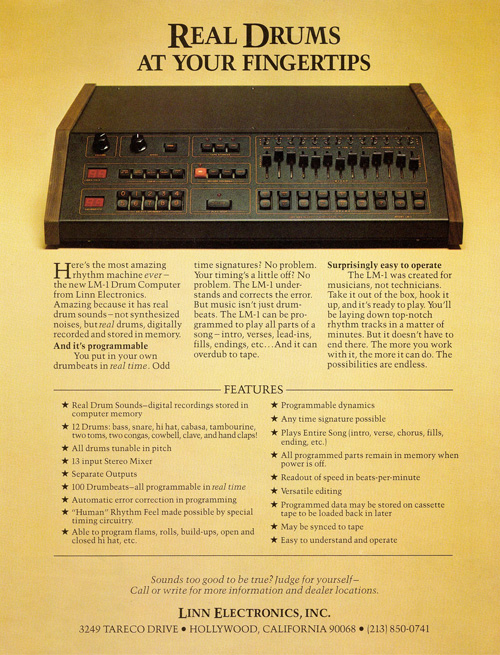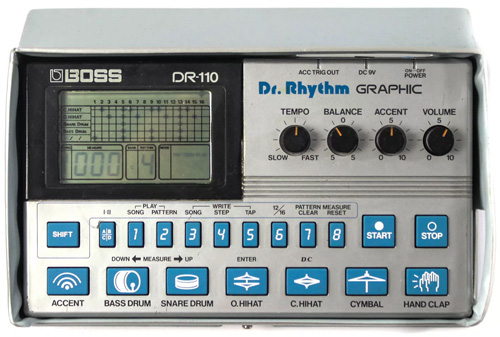The drum machines of the 1980s might be a bit quirky and cheesy, but they’re still essential additions to any gearhead’s ever-evolving collection. Whether you’re seeking a unique sound for your latest recording, fronting a retro cover duo, or just want a beat to jam to, the vintage drum machine is a unique and collectible alternative to modern day software.
As digital effects technology grew in the '80s, digital effects pioneers realized that the drum machine was the perfect candidate for rapid and lucrative development. Musicians were gifted with affordable, user-friendly units that featured sequencing and tone variation options like never before.
I’ve detailed three seminal ‘80s offerings – two classics and one under-appreciated alternative – which were groundbreaking at the time and remain relevant today. I focused on these machines’ innovative features, usability and relevance to contemporary artists.
Roland TR-808
- Defined modern hip hop
- Still an industry standard for rap, hip hop, and R&B
- Can record 32 percussive rhythms incorporating up to 11 sounds plus accents
- Offers specific customization for each sound
Let’s start with the party favorite: Roland's venerable and highly prized TR-808. If your downloaded drum emulator does not feature an “808” suite, it is in the sad and lonely minority – this is arguably the most sought-after and enduring drum machine ever produced.
The TR-808 didn’t replicate acoustic drum sounds. But the resonant kick, unique snare, clap and tom sounds meshed well with the age of electronic music and ensured the 808’s longevity through the hip hop, dance and modern electronica eras.
Available new from 1980 to 1983, the 808 used artificial analog voices controlled by digital sequencing and editing software. According to the operating manual, it could compose and record “32 percussive rhythms incorporating up to 11 sounds, plus accents. Each of these percussive sounds has its own level control for full mixing flexibility over the total sound, and each sound also has its own separate output so that it can be mixed or processed separately from the others.”
Step programming allowed each quarter-note beat to be divided into eight steps which were programmable in sequenced or real-time via 11 voice buttons. Sounds could be as compact as 30 second increments.
The TR-808 ushered in an era of relatively affordable beat production and user-friendly sequence composition and storage. Other features, like three remote sync triggers and the Auto-fill selector, endeared the Roland to those who could afford the original $1,195 asking price.
Such is the popularity and demand for the TR-808, Roland’s usual reluctance to reboot older technologies was suspended long enough to produce the 808/909 hybrid – the TR-8. The TR-8 addressed some of the 808's limitations, like its spartan LED indicator display (the memory storage technology of the time) and the fact that it was released prior to the standardization of MIDI protocols. The TR-8 incorporated the best of the 808 and subsequent 909 tones with the added convenience of USB interfacing for MIDI and computer connectivity.
Japanese group, The Yellow Magic Orchestra, is credited with being the first group to exploit the TR-808. Soon after, artists such as Marvin Gaye, 2 Live Crew, New Order and the Beastie Boys (who mentioned it by name) put their stamp of approval on the unit as well. The TR-808’s signature sounds are considered essential for modern dubstep, hip hop, R&B and electronic rock, and any well-equipped studio is sure to have one (or an emulator, at the very least) on hand. If you can’t find an original TR-808, try the TR-8.
Linn LM-1 Drum Computer
- Real samples of acoustic drum sounds, not digital
- Real-time programming
- 13-channel stereo mixer
- Beloved by Prince
Roger Linn’s marvelously innovative LM-1 Drum Computer was released in 1980 as one of the first ever programmable machines available. Realizing the potential of rapidly evolving sampling technology, Linn matched real samples of drums with a digital delivery system instead of producing the sounds digitally.

The LM-1 was hailed as revolutionary, capable of producing replication that far exceeded TR-808 style synthesis. The innovation was reflected in the price, however, and owners paid a premium of around $5,000 to get one.
Mirroring the TR-808’s 1980-1983 production run, the LM-1 began as a garage project that just kept growing. Linn was frustrated with rhythm machines more suited to Grandma’s church organ than a guitarist’s home studio, so he set about learning computer programming to try and make something of his own. The result was a cardboard box full of components that produced 8 bit 28 kHz samples of analog drum tones, purportedly suggested by Toto’s Steve Porcaro and provided by session maestro, Art Wood.
Stevie Wonder, Peter Gabriel and Fleetwood Mac were among the first to buy the production models. Their purchases legitimized drum machine usage, which had previously been considered an expensive novelty.
The LM-1 offered 12 tunable drum tones with individual voice outputs, real-time programming, a 13-channel stereo mixer, BPM meter, auto-correct capability and cassette tape data storage (similar to older readers’ Commodore 64 datasets).
Early models used high-end components, engraved tone buttons, and featured other small luxuries that were eventually phased out to cut costs. Roughly 700 of these LM-1s were produced in total, so although originals still exist, they are quite rare. Nonetheless, those who can get their hands on one often prefer the LM-1 to its successor, the LinnDrum or LM-2.
Like the TR-808, the LM-1 uses LEDs for tracking, which sometimes presents difficulties for those who are more accustomed to modern VDUs. It also lacks cymbals, though this has always been a minor issue. At the time, studio engineers would often overdub the required crash or ride, and a modern sequencer would be able to supply the missing metalwork for today’s users.
Although the technology may be outdated and interfacing with modern equipment challenging, the LM-1 is prized for its sounds above all else. Championed by artists such as Prince, The Cars, The Human League and a myriad of others, a simple audio interface and your favorite step-sequencing software will allow modern users to enjoy composing and recording with the LM-1.
While the LM-1 has never been afforded the reissue treatment, it lives on through emulation software, from complete virtual units to samples available in broader spectrum programs. This can be an excellent and necessary alternative for most people, as originals are far from cheap. The last one I found went for $3,500 – unearthing one for under $3,000 could make a wise investment if you should be so lucky.
Boss DR110 Graphic
- Still affordable
- Super compact – take it anywhere
- Despite its size, it still produces thick and meaty drum sounds
This little beast is a bit of an outlier because it doesn't enjoy the celebrity endorsements or iconic status of the aforementioned machines. However, that does not mean it is meritless or unworthy of mention.

Released in 1983 as the successor to the original 1980 DR-55, the Boss Doctor Rhythm 110 Graphic became the affordable and versatile go-to drum machine for musicians seeking a user-friendly step-sequencing machine with state-of-the-art components and the best digital display of the time. Many remain in service today, and the DR110 is the most affordable of the three machines featured here, originally retailing for around $200.
Users of the DR110 were immediately impressed by the simplistic layout, expanded voice package and generous grid-sectioned LCD screen, which prompted the “Graphic” designation. This cutting-edge screen was a huge improvement over the flashing LED indicators installed on the Roland and Linn designs, and later offerings like the Yamaha RX17 (1987) only provided a single-line display.
Like the 808, the DR110 generated synthesized analog voices rather than sampled drum tones. But by 1983, electronic drum sounds had become commonplace and were widely accepted and actively sought after.
The scrolling display could be augmented by beat pattern templates photocopied from the owner’s manual to assist in composition, and real-time tap record or step-sequencing options were simple to use. Buttons were responsive and the DR110 was a compact, well-designed package with an ergonomically pleasing layout for freestyle jamming.
Sound-wise, I would consider the Boss to be the middle ground between the 808’s synthesized tones and the 8-bit sampled voices of the LM-1. Six voices were available and the outputs included a headphone and a main output, which could be used with a quarter-inch jack stereo output adapter to enable an input signal to be mixed in. The DR110 offered 16 programmable user patterns and 16 preset patterns.
While considered an entirely adequate rhythm sequencer for the budget price, it lacks individual outputs, tunable voices, and MIDI compatibility. This is where the more pedestrian DR falls short of the 808, having no sync triggers to mate the unit to other devices.
Help is at hand, however. The simple componentry of the DR110 lends itself to modification, and there are numerous online forums relating to upgrades with kits available to address syncing issues and voice mods. Paul Barker from DinSync released a limited run of modules for Eurorack synths, dubbed the DrumDokta DRM-110. They use cloned DR-110 circuitry, address output, sync and voice tuning issues. Today, the units are highly sought after in the used market.
The DR-110 is an interesting alternative to the 808 for your next dubstep or hip hop track. It is also great for guitarists sketching out patterns for their drummers to work with, solo practice, composition or for simple accompaniment.
Boss never reissued the DR-110, but the series has evolved and continued with the budget priced DR-3 and the more serious DR-880 available new. Used prices have risen somewhat due to the interest in the unit for modification and resale, but bargains can still be had if you’re patient.
Honorable mentions go to the Alesis HR-16, the Yamaha RX-5 and the E-mu SP1200, as these were also influential and innovative machines. I’d invite comments from those who’d like to add their recommendations and experience below.
